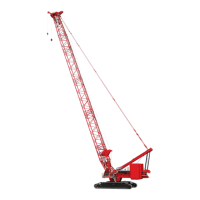HOISTS MLC165-1 SERVICE/MAINTENANCE MANUAL
5-4
Published 05-26-17, Control # 238-02
Working and Pilot Flow Components
See Figure 5-2 on page 5-2.
Control Handle
When the operator moves a control handle off-center, the
hydraulic valve on the control handle allows flow into either
the up or the down pilot circuit. The pressure in the pilot
circuit will be proportional to how far the operator moves the
handle.
In the control handle is an electric coil-operated rotation
indicator (“thumper”) which pulsates with a frequency
proportional to drum speed. This communicates to the
operator that the drum is turning and how fast. The coil
responds to a voltage signal which originates at the drum
speed sensor.
NOTE A control handle can operate different hoists
depending on the mode the operator has entered
into the main display. This is covered in more detail
in the MLC165-1 Main Display Operation manual.
Solenoid Valve, Pressure Transducer, and
Proportional Valve
In the up and down pilot circuits, between the control handle
valve and the directional control valve, is the pilot signal
valve manifold. This manifold contains the solenoid valve,
pressure transducer, and proportional flow valve. These
three components are in each up and down circuit.
The solenoid valves are turned on or off according to how
the operator configures the crane in the GUI screens. These
valves allow different control handles to operate different
drums by directing pilot flow to different hoist circuits.
The solenoid valves are also used by the crane software to
stop hydraulic flow when operating limits are met, such as
the maximum boom angle limit.
The pressure transducers provide the control system with
a variable 1–5Vdc corresponding to the pressure in the pilot
circuit (as determined by control handle position).
The 1–5Vdc is used for two purposes:
• It signals the control system that a control handle has
moved off center
• It is processed by the control system to determine the
appropriate displacement control signal to Drum 1 and
drum 2 motors.
The proportional flow valves are used to limit the motor
speed by a percentage. This percentage is set by the
operator in the crane control screens (see the MLC165-1
Main Display Operation manual for instructions).
Directional Control Valves
The directional control valves are situated on a manifold
which is divided in half, with three directional control valves
(travel and hoist motors) on each half. Each manifold half is
supplied by one flow from the main pump and has separate
working and load sense circuits.
The load sense system connects each directional control
valve to the main pump displacement control. The load
sense system is designed so that the pump responds to the
directional control valve that has the highest working
pressure (greatest load demand). When the manifold is in
the divided condition, one pump half responds to the
demand of three directional control valves.
However, when the Drum Speed switch is in the closed (High
Speed) position, the manifold halves are connected so that
both pump flows are joined to supply all six directional
control valves equally. Also joined are the sense circuits so
that each pump responds equally to load demand.
The up and down handle control circuits terminate at the
directional control valve. This means that pressure from the
control handle valve acts upon on one side or the other of the
directional control valve, resulting in working flow being
directed to one side of the motor or the other. The amount of
pilot pressure from the control handle determines how far the
directional valve spool will open.
Drum Brake
A disc-type brake is installed between the hoist motor and
the hoist gearbox. The brake is spring-applied and
hydraulically released in response to control handle
movement.
When the control handle is moved off center, the controller
responds to a pilot pressure signal and correspondingly
sends a 24Vdc signal to the brake valve solenoid. The brake
valve shifts to allow pilot pressure to flow through the brake
defeat valve to the brake, and the brake releases.
Note that, the brake defeat valve is piloted open anytime the
engine is running.
When the control handle is moved back to center and the
controller sees zero pilot pressure for a set amount of time,
the brake valve shifts to vent the pressure from the brake to
tank, and the brake spring applies.
If pressure is lost to the hoist motor for any reason, the brake
defeat valve closes to vent the pressure from the brake to
tank. This allows the brake to immediately apply to stop the
hoist drum from lowering.
